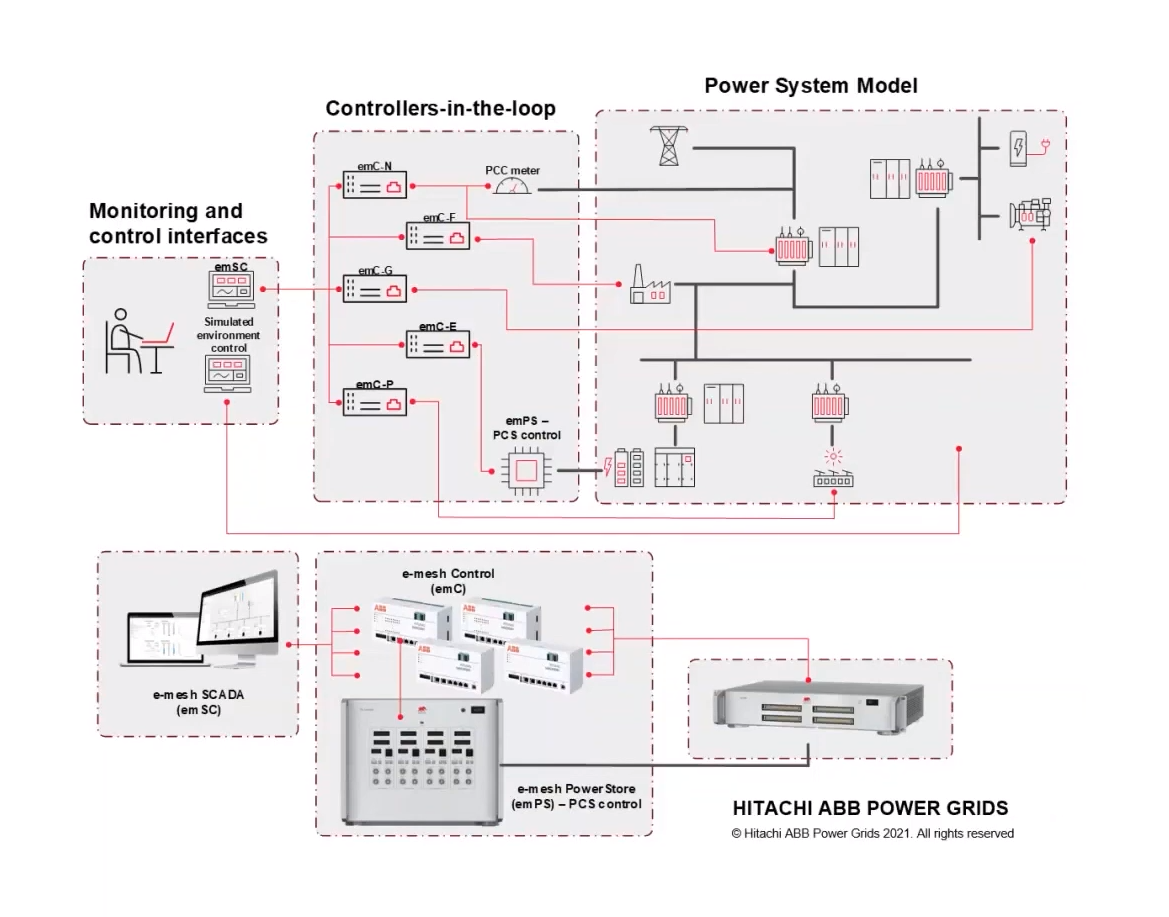
Michele Fusero is an R&D engineer and control specialist for the e-mesh PowerStore Battery Energy Storage System (BESS) at the Grid Edge Solutions Product Group at Hitachi Energy. He delivered a talk at the virtual PEDG2021 conference on how HIL became the pillar of the e-mesh solution product development. Watch the video above or read the full blog article to learn more.
Introduction | What is e-mesh?
The Grid Edge Solutions group at Hitachi Energy is leading the energy innovation and transition with their vertically integrated grid-edge solutions for energy optimization, management, advanced control, and monitoring.
“Our target is to maximize the integration of renewable energy sources, increase the reliability and resilience of the system, lower the CO2 emissions, and reduce the energy costs.
Michele Fusero
Senior R&D Engineer
Hitachi Energy
The e-mesh™ PowerStore smart BESS is the foundation of the power part of the e-mesh solution, with certified compliance and continuous integration of grid codes for many countries (learn more in Video 2). The system also has an automation part with management capabilities and a digital element that allows for remote monitoring using Internet-of-Things (IoT) technologies and performance optimization using Software as a Service (SaaS) solutions (see Fig. 2).
Video 1. Learn more about the e-mesh™ BESS solution development and test automation from the PEDG2021 conference presentation recording, delivered by Michele Fusero (Hitachi Enertgy) and Henrique Magnago (Typhoon HIL).
Michele is an expert in automated Hardware-in-the-Loop (HIL) applications for control testing and verification, as his team has been using this methodology extensively in their e-mesh PowerStore BESS product development. Below are his five reasons why HIL became the pillar of his team’s daily work (learn more in Video 1).
#1 Balance | HIL testing methodologies provide the optimal balance of cost and fidelity for digital control development and testing.
Testing is the most powerful solution to guarantee that e-mesh products are robust, reliable, and efficient. The available testing solutions range from fully simulated to fully physical environments, with test coverage and test fidelity being the key differentiators between them (see Fig. 1).
“Controller and Power HIL provide an optimal balance of good test coverage, fidelity and low or moderate cost.
Michele Fusero
Senior R&D Engineer
Hitachi Energy
The higher the portion of simulated components, the higher the test coverage in terms of the range of scenarios that can be safely tested without damaging equipment. At the same time, virtual models bring approximations that can reduce test fidelity.

Figure 1. Control testing methodology comparison based on test coverage, test fidelity, and test setup cost.
R&D teams often work with Controller HIL (C-HIL) and Power HIL (P-HIL) setups, as they proved to have an efficient compromise of coverage and fidelity at low to moderate costs. C-HIL allows engineers to combine the real and simulated components specifically designed for test targets with high test coverage and up to 95% model fidelity (see Fig.1).
#2 Automated checks | Automated C-HIL testing allows repeatable, scalable, and reusable tests during control software development.
At Hitachi Energy, the HIL testing is used to validate algorithms developed for both grid-connected and off-grid operation daily. A sanity test suit runs each developed function, assesses response speed, control stability, and reaction to Low Voltage Ride-Through (LVRT), and verifies compliance with target grid codes and specific customer requirements. Automated test scripts open up space for the creation of repeatable, scalable, and reusable tests.
“With automated testing, we can break down our test procedure in a list of commands, collect it in a script, and run these scripts as many times as we need to.
Michele Fusero
Senior R&D Engineer
Hitachi Energy

Figure 2. Unit-level HIL setup with two detailed PowerStore control units interfaced through analog and digital signals with the simulation. The connection to the grid is controlled with a virtual breaker and control profiles with different loads created to test control regulation.
Using PyTest, pass and fail conditions can be set, and automated unsupervised reports generated for quick sanity checks after each control firmware update. This allows engineers to quickly check all the functionalities for any implemented firmware change, revealing unexpected effects of the update to be fixed before being sent to end-users. The scripted automated HIL testing helps not only with that but can be used for fine-tuning through iterated testing.
#3 Pre-certification | HIL testing enables pre-certification testing for grid-code compliance.
Grid-tied devices need to pass certification for country-specific grid codes in order to be sold and implemented in the market. HIL testing can be used for pre-certification, so issues can be uncovered and addressed during virtual testing. This later minimizes the testing time and costs during certification procedures.
“You can very inexpensively fix issues before sending the product for certification.
Michele Fusero
Senior R&D Engineer
Hitachi Energy
Also, since certification standards are constantly evolving, adapting the test to fulfill an updated standard can also be quite fast. The team can start automating their tests from day one - testing modulation, current loops, voltage loops, protection, all the way to power loops, grid support functionalities, and the grid codes - one addition at a time.
Video 2. Hitachi Energy Spotlight #1 | Microgrid e-mesh™ Digital Ecosystem - vertically integrated solution.
#4 Control Verification | System-level HIL testing enables verification of control logic coordination behind distributed control.
In a system-level HIL setup, we can test distributed control. Here, a controller is tied to each distributed energy resource (DER), and the individual controllers are interconnected with each other. This enables the verification of the coordination of control logic that runs on different hardware and at different speeds. Communication, management, and control utilization can also be tested, to avoid potential problems that could arise during operation.

Figure 3. Illustration on how system-level HIL testing is performed.
#5 Integration | HIL enables product optimization through customized testing on digital twins of customer plants.
To avoid issues that could occur when the solution is implemented on-site, the entire system can be tested on digital twins of customer plants. It is possible to build and test the entire site in the HIL environment, which can reduce commissioning time. Configurations can be ported from the site, issues reproduced within the simulated lab environment, problems addressed and fixed, and then the configuration sent back to the site. This way, the product can be specifically tested and its performance verified and optimized for customer plant environments.
Video 3. Hitachi Energy Spotlight #2 | Microgrid e-mesh™ Digital Ecosystem - HIL setup for system-level distributed DER control testing.
Conclusion | HIL use beyond development.
Besides the five reasons for using HIL in product development, there are two more important benefits of using HIL worth mentioning. First off, it’s extremely valuable to have the possibility to use the same high-fidelity tools during the development, integration, and product maintenance stage. Since usually, different engineering teams work on each of these stages, having the opportunity to use the same vertically integrated tools can facilitate efficient communication of relevant data. This leads to savings in time and money, especially during product integration and maintenance, where large chunks of knowledge generated by the development and testing teams remain close at hand.
Secondly, creating HIL Compatible devices eases product integration and creates long-term value. Any product’s digital twin model can be packaged into a library that can be easily shared containing all the IO mapping for that specific HIL Compatible controller. Now the system integrator can add this library component to their system model alongside the HIL Compatible device hardware and run all the integration tests they need.
If they find any issues on either the model or the performance of the product, they can forward this feedback to the original equipment manufacturer (OEM), which would improve the model and/or firmware, run the automated test verification and validation process again, and distribute the updated model and firmware to all their customers.
With HIL, Hitachi Energy is creating long-term value for its customers throughout the entire product lifecycle.
Are you exploring adopting HIL in your work?
Contact us to schedule a free demo.
Do you want to start building automated tests?
Read more about TyphoonTest IDE.
Do you want to learn more about e-mesh?
Read the Hitachi Energy Success Story.
Text | Debora Santo, Henrique Magnago, Samantha Bruce
Images | © Hitachi Energy Power Grids 2021. All Rights Reserved.
References | The blog is based on a talk given by Michele Fusero at the PEDG 2021 conference. The conference recording is provided as a resource within the blog.



